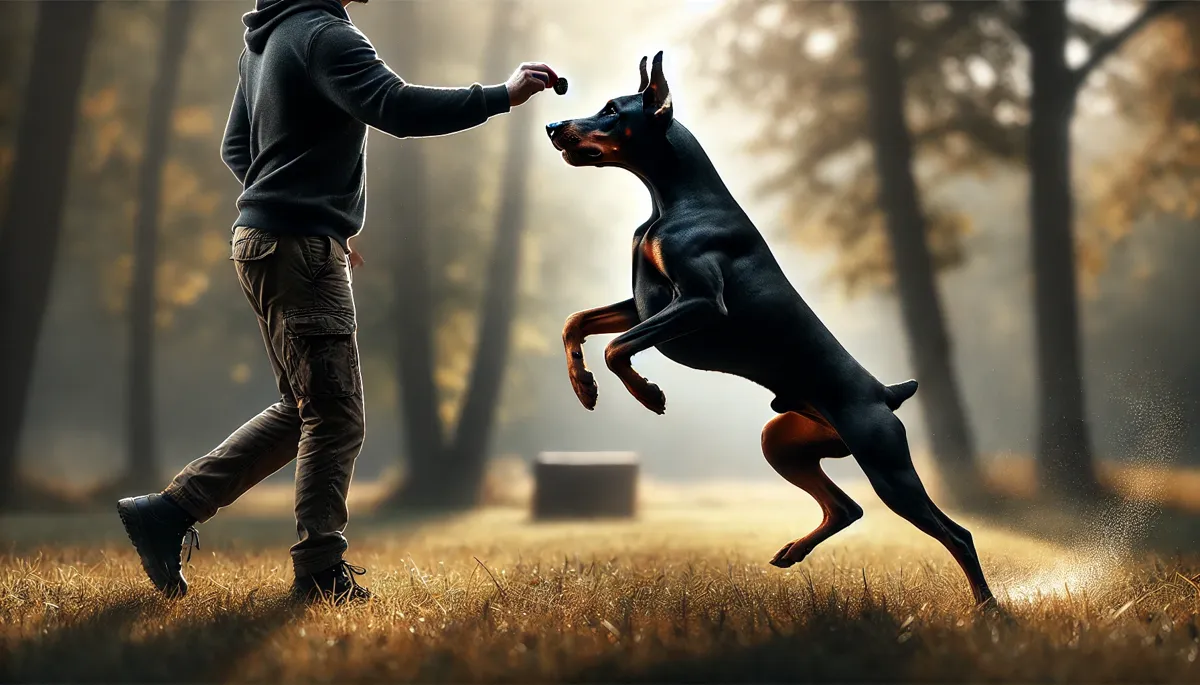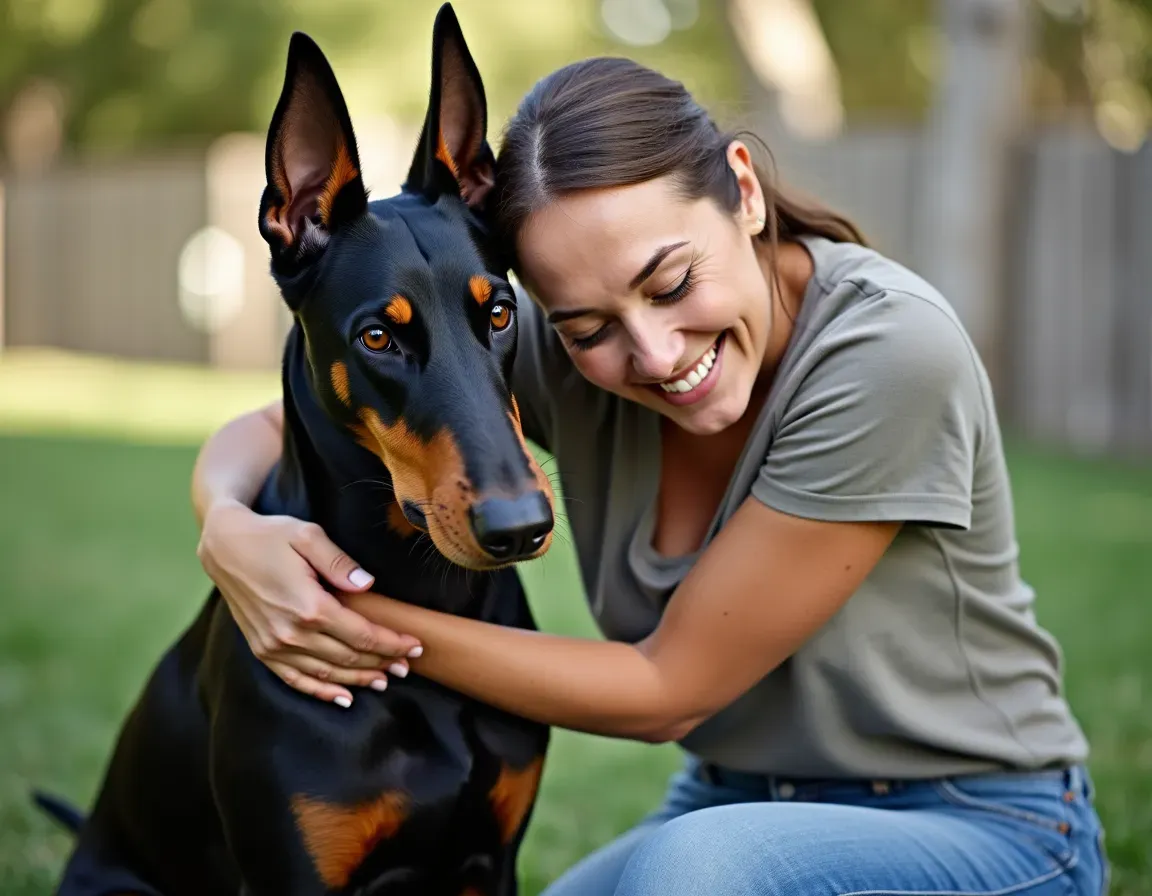The Doberman is a dog with an impressive physique and a sharp mind, but it is much more than just a guard dog. Indeed, this breed is known for its intelligence, loyalty, and attachment to its family. Its athletic appearance and great elegance leave no one indifferent. But before adopting a Doberman, it is important to fully understand its needs, behavior, and health specifics.
Origins of the Doberman #
The origins of the Doberman date back to the late 19th century in Germany. This breed was created by Karl Friedrich Louis Dobermann, a tax collector who sought a dog capable of protecting him in his often risky work. By crossing different breeds such as the Rottweiler, the German Pinscher, and probably the Greyhound, he managed to develop a fast, intelligent, and naturally protective breed.
Since then, the Doberman has established itself as a reference in roles as a guard and working dog, but also as an excellent family companion.
Physical Characteristics of the Doberman #
The Doberman is a breed with an athletic and slender appearance, distinguished by its elegant and muscular stature.
Size and Weight of the Doberman #
The Doberman is a large and very imposing dog.
| Gender | Height | Weight |
|---|---|---|
| Males | 27 to 28 inches | 88 to 99 pounds |
| Females | 25 to 27 inches | 70 to 77 pounds |
These dogs are robust while being very agile, with a build that allows them to excel in canine sports and intense physical activities.
Coat Color #
The Doberman’s coat is short, smooth, and dense, making it easy to maintain. The most common coat colors are:
- Black and tan
- Brown and tan
- Blue (rarer)
- Isabella (rarer)
The tan markings are typically located around the eyes, muzzle, chest, and legs.

Specific Characteristics of the Doberman #
The Doberman has some distinctive physical characteristics, notably its long and narrow head, with a well-defined muzzle. Although it is large, its body is muscular and streamlined for speed.
While it has naturally drooping ears, this is rarely seen as they are often cropped at a young age in some regions. The same goes for their tail. The purpose of these manipulations is to give them a more intimidating appearance. Fortunately, these practices are increasingly banned!
Behavior of the Doberman #
The Doberman is a smart, protective, and loyal dog. Its behavior is strongly influenced by its education and socialization.
Behavior with Children #
The Doberman is generally gentle and protective with children, but due to its size and energy, it is essential to supervise interactions, especially with younger ones. It can quickly become attached to the most vulnerable family members, and its protective instinct makes it a reliable companion.
Behavior with Other Animals #
Regarding other animals, the Doberman can peacefully coexist with other dogs and even cats, especially if socialized from a young age. However, it can be dominant with other dogs, particularly of the same sex. Early socialization and gradual introduction are therefore essential to avoid tensions.
Health of the Doberman #
The Doberman is generally healthy, but it is predisposed to certain hereditary diseases. Regular veterinary check-ups and special attention to its specific needs can help prevent or manage these conditions.
Life Expectancy #
The life expectancy of the Doberman is between 10 and 13 years, depending on its overall health and the quality of care provided throughout its life.
Common Diseases #
Like any breed, the Doberman can be prone to certain genetic diseases. Here is a summary table of the main conditions this breed is exposed to.
| Disease | Description | Probability |
|---|---|---|
| Dilated Cardiomyopathy (DCM)* | Heart disease affecting the heart muscle, reducing its pumping capacity. | High |
| Hip Dysplasia | Malformation of the hip joint, affecting mobility and possibly requiring surgery. | Medium to high |
| Von Willebrand Disease | Blood clotting disorder leading to excessive bleeding. | Medium to high |
| Wobbler Syndrome | Compression of the spinal cord in the neck, causing motor disorders. | Medium to high |
| Progressive Retinal Atrophy | Degeneration of the retina leading to progressive vision loss. | Medium to high |
| Hypothyroidism | Thyroid gland dysfunction causing lethargy and weight gain. | Medium |
| Dermatological Problems | Skin allergies and infections. | Medium |
| Obesity | Excess weight that can worsen back and joint problems, as well as heart diseases. | Medium |
| Drug Sensitivity (MDR1) | Severe reaction to certain medications, potentially fatal. | Medium |
*DCM affects nearly 50% of Dobermans and requires regular monitoring of heart rate.
Heart and Respiratory Rates of the Doberman #
Thanks to the many Dobermans equipped with Minitailz, we have recorded the following figures in healthy dogs:
| Median Heart Rate | Median Respiratory Rate |
|---|---|
| 60.6 BPM 50% of them have a rate between 57.1 and 64.1 BPM |
13.8 RPM 50% of them have a rate between 11.3 and 14.7 RPM |
Training the Doberman #
Training the Doberman should be rigorous but kind, as this intelligent breed responds very well to positive training methods. It is important to provide it with sufficient mental and physical stimulation to avoid boredom, which can lead to destructive behaviors.
✔️ Positive Training Methods #
The Doberman learns quickly with methods based on reward and positive motivation. For effective training:
- Use treats to reward good behaviors.
- Conduct short but regular sessions to maintain its attention.
- Use verbal encouragement and petting to reinforce desired behaviors.
- Avoid punitive methods, as they can cause stress and frustration in the Doberman.

✔️ Importance of Early Socialization #
Early socialization is crucial for a Doberman to avoid territorial or aggressive behaviors. From a young age, it is essential to:
- Expose it to different environments: explore the streets and parks around you to get it used to different conditions.
- Get it used to the presence of people of all ages: introduce it to your relatives from a young age, especially children, so it gets used to their presence and develops a gentle behavior with them.
- Gradually confront it with other animals: to avoid aggression, it is essential for it to meet other animals. This will teach it to share its territory.
- Encourage positive interactions with strangers: to reduce distrustful behaviors, it should be exposed to people it doesn’t know.
✔️ Learning Cleanliness #
The Doberman quickly learns cleanliness with a well-established routine. Here are some tips to facilitate this learning:
- Take it out regularly and at specific times (after meals, upon waking, before bed).
- Praise it every time it does its business outside.
- Do not punish it in case of an accident, but be more vigilant about outing times.
- Use keywords like “outside” or “pee” so it associates the action with a command.
✔️ Teaching Basic Commands #
The Doberman is receptive to learning basic commands. To teach it orders like “sit,” “lie down,” or “stay,” it is important to:
- Start from a young age to establish good habits.
- Use rewards to reinforce obedience.
- Repeat training sessions regularly so it assimilates the commands.
- Gradually introduce distractions to test its obedience in more stimulating environments.
❌ Managing Undesirable Behaviors #
The Doberman can sometimes develop undesirable behaviors, such as aggression or destruction. To correct these behaviors:
- Identify the source of the problem (stress, lack of exercise, boredom).
- Redirect its energy towards positive activities, such as play or training.
- Be consistent with house rules to avoid confusion.
- If persistent, consult a professional dog trainer for tailored advice.
Examples of Training Exercises #
The Doberman is a dog that loves physical and mental exercise. Here are some exercises suitable for keeping it occupied and reinforcing its obedience:
- Agility: Set up obstacles in your garden for it to jump, crawl, or go around.
- Tracking: Hide objects in the house or garden and encourage it to find them.
- Learning new tricks: In addition to basic commands, teach it more complex tricks, like fetching an object or playing dead.
- Ball games: Use a ball or frisbee to keep it fit and stimulate its chasing instinct.
Character and Lifestyle of the Doberman #
The Doberman is both energetic and affectionate. It requires a good dose of daily exercise to stay balanced and happy.
Physical Activity and Exercise #
The Doberman needs a lot of exercise to expend its energy. Activities such as running, long walks, or agility games are ideal for allowing it to let off steam. A minimum of one to two hours of physical activity per day is recommended.
Indoor Character #
Although the Doberman is very active outdoors, it knows how to be calm and affectionate indoors, especially after expending its energy. It loves being close to its owners and is often considered a “velcro dog.” It enjoys quiet family moments and can relax with its owners after a busy day.
This dog is also very attentive to its environment, and its guarding instinct drives it to monitor everything happening around it, even indoors.
Character with Family and Other Animals #
The Doberman is extremely attached to its family and will do anything to protect it. This strong bond, combined with its intelligence, makes it very responsive to its owners’ emotions and needs.
It is also capable of cohabiting well with other animals, but this greatly depends on its initial socialization. If a Doberman is properly socialized from a young age, it will get along well with other dogs, even cats. However, if it hasn’t been exposed to other animals early on, it may show signs of dominance or distrust towards them.

Living Environment #
The Doberman can adapt to different types of environments, but it needs space and exercise to be happy. Ideally, a house with a garden would allow it to let off steam between walks. However, it can also live in an apartment provided it gets long daily walks and regular physical activities.
The Doberman is very close to its owners and doesn’t like being left alone for long periods. It is therefore important to provide it with company or activities in your absence to avoid separation anxiety.
Care and Hygiene of the Doberman #
The Doberman is a dog with relatively easy maintenance due to its short and smooth coat, but it still needs regular attention to stay healthy and comfortable.
Brushing the Doberman #
A weekly brushing is enough to remove dead hair and keep its coat shiny. This simple gesture also allows monitoring the condition of its skin and preventing dirt buildup.
During shedding periods, in spring and fall, it may be necessary to brush it more often to control hair loss.
Bathing #
The Doberman doesn’t require frequent baths, but a bath every two to three months is recommended, or when the dog is particularly dirty. Use a gentle shampoo specifically designed for dogs to preserve its skin health.
Dental Hygiene #
As with all dogs, it is important to brush the Doberman’s teeth regularly to prevent dental problems and bad breath. Chew toys or dental treats can also help maintain good oral hygiene.
Ear and Nail Care #
Its ears should be cleaned regularly to prevent infections, especially if it has drooping ears. Nails should be trimmed about once a month to prevent discomfort or injury.
Feeding the Doberman #
The Doberman’s diet plays a crucial role in its overall well-being. A balanced and high-quality diet is essential to maintain its health and energy. Here are some points to consider regarding its diet:
- Quantity: The Doberman needs a diet rich in proteins and nutrients to maintain its musculature and support its energy needs. An adult dog will need about 2 to 3 cups of kibble per day, divided into two meals.
- Quality of Kibble: Opt for premium kibble or foods specifically formulated for large breed dogs. These kibbles contain the right ratios of proteins, fats, carbohydrates, as well as essential vitamins and minerals.
- Weight Monitoring: The Doberman can be prone to obesity if it doesn’t get enough exercise or if its diet isn’t balanced. Regularly monitor its weight and adjust the amount of food based on its activity level.
- Dietary Supplements: In some cases, supplements such as omega-3 fatty acids for skin and joint health, or probiotics for healthy digestion, can be beneficial. Consult a veterinarian to determine if your dog needs supplements.
It is also essential to always provide fresh water for your Doberman to keep it properly hydrated, especially after exercise.
Adoption and Cost of the Doberman #
Adopting a Doberman is a serious commitment, as this breed requires not only time and attention but also a significant budget to ensure its well-being.
Price to Adopt a Doberman #
The price of a Doberman varies depending on the breeder and the dog’s lineage. A Doberman puppy from a reputable breeder generally costs between 1,000 and 2,000 €. Some breeders specializing in champion lines may offer puppies at a higher price.

Maintenance Cost #
The Doberman requires regular maintenance, veterinary care, and quality food to stay healthy. Here is an overview of the average annual costs to maintain a Doberman:
- Food: 500 to 700 € per year for quality food adapted to its size and energy needs.
- Veterinary Care: 200 to 400 € per year for vaccinations, health checks, and preventive care (deworming, antiparasitics).
- Health Insurance: About 300 to 600 € per year depending on the chosen coverage, especially for common diseases like dilated cardiomyopathy.
- Training and Activities: Training classes or sports activities, such as agility or tracking, may represent an additional cost.
Of course, this budget varies depending on your location and habits!

